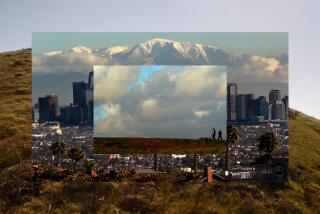A Wonderland Awaits in Mt. Rainier National Park
- Share via
In the pantheon of long-distance pathways, the Wonderland Trail occupies an exalted place. Many experienced backpackers call it the Pacific Northwest’s greatest hike.
It’s an old trail as national park trails go, constructed at the turn of the century just after Mt. Rainier National Park was established in the state of Washington. Long before the park was ringed by paved highways, rangers used the Wonderland Trail to patrol Rainier on horseback. During the 1930s, Civilian Conservation Corps efforts made Wonderland into the nationally recognized recreation trail it is today.
Long ago, “Wonderland” was a park promoter’s phrase; in this instance, the name did not overstate the region’s allure. The Wonderland Trail tours a grand assemblage of alpine meadows, thick forests, awesome glaciers, dramatic creeks and rivers. With every turn there is a different view of the many faces of Mt. Rainier.
This year marks the 100th anniversary of the park, about a two-hour drive southeast of Seattle, and rangers are planning special interpretive programs this summer to celebrate.
One good way to observe the occasion is to hike Mt. Rainier, which has the kind of superlatives expected of a national park: the tallest volcanic mountain in the continental U.S. (14,410 feet) and the mountain with the most active glaciers (26) in the U.S. Add nearly 400 lakes and some of the finest alpine meadows in the world and you have quite a park.
An excellent way to get in the mood for a ramble ‘round Rainier is to browse an engaging, large-format new book about the park, “Washington’s Mt. Rainier National Park: A Centennial Celebration” (The Mountaineers, $35), with text by Tim McNulty and inspiring photography by Pat O’Hara.
The prudent hiker will allow 10 to 14 days for a full circumnavigation of the mountain (a 93-mile loop), but encounters with bad weather can considerably slow progress. In decent conditions, an average of seven to 10 miles is about the maximum per day, veteran hikers advise, as the trail has lots of ups and downs. Several days require climbs of 3,500 feet or more; the whole route entails gains in excess of 20,000 feet.
Some hikers consider hiking the Wonderland a terrific summer vacation and complete the whole mountain-encircling route at one time. Others tramp the trail in sections, savoring the Wonderland a few days at a time.
Logistics are a bit complicated. The 18 Wonderland Trail camps are situated three to seven miles apart, and reservations are required. National Park Service policy has been to limit the number and capacity of campsites. Critics say this unduly limits backpacking, while others praise the policy and suggest it provides a superior wilderness experience for both day hikers and backpackers.
Required back-country permits are issued at the Hiker Information Centers in Longmire and White River. As part of the permit process, you must commit to a particular trail-side camp; exercise a little flexibility here because your first choice might be full.
Another option for experienced hikers is to use “cross-country zones,” where backpackers find their own places to camp. Such camps are required to be at least a quarter-mile from roads and trails and a minimum of 100 feet from any water source.
You certainly won’t want to carry two weeks’ or even 10 days’ worth of food on your Wonderland walk. Take advantage of the National Park Service’s Food Cache Program and store a food cache or two or three. The park has detailed instructions on the right waterproof and rodent-proof containers, how to ship them (UPS) and the five stations--Paradise, Sunrise, White River, Ohanapecosh and Longmire--where you may stash your cache. Try to persuade friends or family to meet you with a fresh food supply; you’ll enjoy the company, and they’ll enjoy a day on the Wonderland Trail.
The Wonderland can be day-hiked from a dozen or so trail heads around the mountain.
The 30-mile route from Paradise to Sunrise is noted for its watery scenery: lakes, waterfalls and a dramatic river canyon. On the 16-mile trip from Sunrise to Carbon River, hikers get up-close views of Winthrop and Carbon glaciers. The 39-mile section from Carbon River to Longmire passes beautiful lakes, including Mowich and Golden lakes, as well as such wildflower-strewn meadows as Sunset Park, Klapatche Park and Indian Henry’s Hunting Grounds. A last 6.5 miles (a good one-way day hike) travels from Longmire to Paradise via Carter, Madcap and Narada falls.
Mid-July through September is the best period for hiking, as the snow has melted to reveal the trail. However, even during these months, rain, fog and poor visibility are often problems, and map and compass navigation may be required.
(BEGIN TEXT OF INFOBOX / INFOGRAPHIC)
Hiking/Mt. Rainier Wonderland Trail
Where: Mt. Rainier National Park, Wash.
Distance: 93-mile loop around Mt. Rainier.
Terrain: Meadows, forests, glaciers on the mighty shoulders of Mt. Rainier.
Highlights: One of the continent’s great long-distance trails.
Degree of difficulty: Strenuous.
For more information: Mt. Rainier National Park, Ashford, WA 98304; tel. (360) 569-2211. Ask for the following park brochures: Wilderness Trip Planner, Wonderland Trail, Food Cache planner.
More to Read
Sign up for The Wild
We’ll help you find the best places to hike, bike and run, as well as the perfect silent spots for meditation and yoga.
You may occasionally receive promotional content from the Los Angeles Times.






